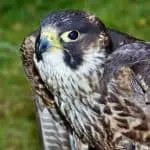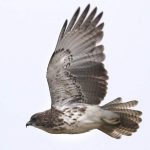Common Name: Barn Owl
Scientific Name: Tyto alba| Size | Diet | Range in Hawaii | Status in Hawaii |
|---|---|---|---|
| 12 in. - 15 in. | small mammals, rodents, eat birds, reptiles, and insects | All Islands | least concern |
Barn owls (Tyto alba) are a type of bird of prey that are found on every continent except Antarctica. They are known for their distinctive heart-shaped face and their ability to hunt small mammals in complete darkness. In Hawaii, barn owls can be found on all of the main islands and are an important part of the local ecosystem.
Barn Owl
Appearance
Barn owls are medium-sized birds of prey that are easily recognizable due to their distinctive appearance. They have a slender, streamlined body, long legs, and a large, round head with a heart-shaped facial disc. Their wings are long and narrow, and they have a wingspan of up to 4 feet, with a body length of about 12-15 inches.
They have a white or pale grey face, with a dark brown or black border around the edges of the facial disc. They have a light brown or tan upper body, with dark brown or black spots on their wings and back. Their underparts are usually white or pale grey, with some dark brown or black spotting.
Diet
Barn owls are carnivorous birds of prey that primarily hunt small mammals such as mice, rats, voles, and shrews. They are nocturnal hunters, using their excellent hearing and keen eyesight to locate their prey in complete darkness.
They are opportunistic feeders, and they will also prey on other small animals such as birds, reptiles, and insects if the opportunity arises. They are known to eat a wide variety of prey, including insects, birds, reptiles, and small mammals.
In addition to hunting for food, barn owls also rely on other sources of sustenance, such as fruit and nectar from flowers. They have been known to visit fruit trees and feed on the berries and other fruit that is available.
Behavior
Barn owls are nocturnal birds of prey that are most active at night. During the day, they roost in quiet, concealed places such as tree cavities, barns, and abandoned buildings. They are solitary birds, with both males and females maintaining separate territories.
Also, they are known for their silent flight, which is made possible by the comb-like structure of their feathers. This allows them to fly quietly and stealthily, enabling them to sneak up on their prey without being detected.
Barn owls are territorial birds and will defend their territory against intruders. They are also monogamous, with pairs mating for life. During the breeding season, males will perform aerial courtship displays, such as hovering and calling, to attract a mate.
Barn owls are vocal birds and have a distinctive, haunting call that is often described as a “screech.” They use a variety of calls to communicate with each other, including hoots, clicks, and whistles.
Nesting
Barn owls typically nest in tree cavities, barns, and abandoned buildings. They prefer secluded, quiet locations with good visibility and access to their hunting grounds.
Barn owls are cavity nesters, meaning that they build their nests inside a natural or man-made hole or crevice. They do not build nests like other birds, but rather line the nest site with soft materials such as feathers, leaves, and grass.
During the breeding season, female barn owls lay a clutch of 2-12 eggs, which are incubated by both the male and female for about 30-34 days. The eggs are white and smooth, and the chicks hatch fully feathered and ready to fledge (leave the nest) at about 5-7 weeks of age.
Both parents contribute to the care of the chicks, with the male bringing food to the nest and the female brooding and feeding the chicks. When the chicks are old enough to leave the nest, they will fledge and begin to hunt on their own. However, they will continue to depend on their parents for food and protection until they are fully independent.
Habitat
Barn owls are found on every continent except Antarctica and are adapted to a wide range of habitats, including grasslands, forests, deserts, and urban areas. They are highly adaptable birds and are able to thrive in a variety of environments as long as they have access to suitable nesting sites and a reliable source of food.
Barn owls require open spaces for hunting, and they often hunt in areas with a mix of grasslands, agricultural fields, and forests. They also need secluded, quiet places for nesting, such as tree cavities, barns, and abandoned buildings.
Range
Barn owls are found on every continent except Antarctica, and they are present in Hawaii on all of the main islands. They are a non-native species in Hawaii, and it is believed that they were introduced to the islands by humans at some point in the past.
Conservation Status
Barn owls are not considered a threatened or endangered species in Hawaii or globally. However, they are facing challenges in many parts of the world, including habitat loss, competition with introduced species, and environmental contaminants.
Interesting Facts
1. Most widely distributed species of owls in the world
Barn owls are one of the most widely distributed species of owls in the world, found on every continent except Antarctica.
2. Heart-shaped face
They are known for their distinctive heart-shaped face and their silent flight, which is made possible by the comb-like structure of their feathers.
3. Excellent hearing
Barn owls have excellent hearing and can locate their prey in complete darkness by listening for the sounds of movement.
4. They are nocturnal hunters
They are nocturnal hunters and primarily prey on small mammals such as mice, rats, voles, and shrews.
5. They are monogamous
Barn owls are monogamous and mate for life, with both males and females participating in the care of their young.
Frequently Asked Questions:
Are barn owls native to Hawaii?
Barn owls are not native to Hawaii and are believed to have been introduced to the islands by humans at some point in the past. They are a non-native species in Hawaii and are not protected under state or federal law.
What are the main threats to barn owls in Hawaii?
Barn owls in Hawaii are facing a number of challenges, including habitat loss and competition with introduced species. Habitat loss is a major threat to barn owls in Hawaii, as many of the forests and grasslands where they live are being converted for agricultural or urban development.
What is the lifespan of a barn owl?
Barn owls have a lifespan of about 5-7 years in the wild, although some individuals have been known to live longer. In captivity, barn owls can live up to 20 years or more with proper care.


